
 |
|
|
|
|
|
|
|
|
Miscellaneous Sedimentary Features in Shales |
|
| Shown features are from the
Newland Formation and the Prichard Formation, both from the Mid-Proterozoic
Belt basin. Newland Formation shales were deposited in comparatively
shallow water, and those of the Prichard Formation in comparatively
deep water. For further information consult a publication from 1990. Schieber, J., 1990, Sedimentary structures, textures, and depositional settings of shales from the Lower Belt Supergroup, Mid-Proterozoic, Montana, U.S.A.: In: Microstructure of Fine-Grained Sediments: From Mud to Shale, (eds. R.H. Bennett, W.R. Bryant, M.H. Hulbert), p. 101-108, Springer Verlag. Link |
|
 |
|
| Photomicrograph of a shale with suspended coarse sand grains (Newland Formation). Material such as this may form lenses within gray dolomitic shales. To have a clay matrix in what appears to be a migrating bedform (starved ripple?) is puzzling. The clay particles of the matrix and the sand grains are not hydraulic equivalents, so how did they get deposited together in these lenses? One possible explanation could be that we started out with clay aggregates or rip-up clasts that traveled together with the sand grains, and that the margins of shale clasts became indistinguishable due to compaction and diagenetic overprint. | |
 |
|
| Photomicrograph of gray dolomitic
shale (Newland Formation). Shows faint internal banding due to
variations in dolomite content (dolomite rich bands are lighter).
The lighter (dolomitic) bands have been interpreted as distal mud
tempestites. Schieber, J., 1989, Facies and origin of shales from the Mid-Proterozoic Newland Formation, Belt basin, Montana, U.S.A.: Sedimentology, v. 36, p. 203-219. Link |
|
 |
|
| Photomicrograph of graded silt/mud couplets in the Prichard Formation. Aside of grading and basal load structures (micro-flame structures), these layers are essentially featureless. In contrast to silt/mud couplets of the Newland Formation they show no indications of wave or current action. They also show none of the features described from muddy turbidites. They may actually be the deposits of short lived lutite flows, possibly induced by storms on the shelf or by river floods. | |
 |
|
| Photomicrograph of wavy-lenticular silt laminae in the Prichard Formation. The lenticular nature and sharp lower and upper boundaries are suggestive of bedload transport over the sea bed. They could be the result of episodic sediment reworking by weak bottom currents. | |
|
|
|
| Back to SHALE RESEARCH LAB Main Page | |
| Back to IU Department of Geological Sciences | |
|
© Jürgen Schieber, IU Bloomington Department of
Geosciences Last updated: February 08, 2022. |
|